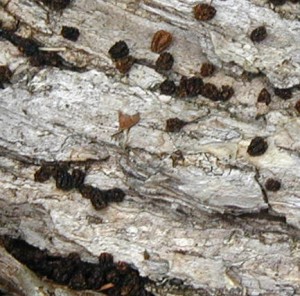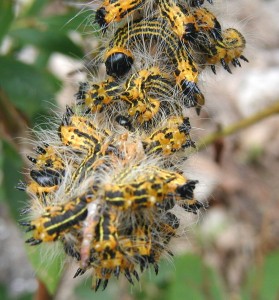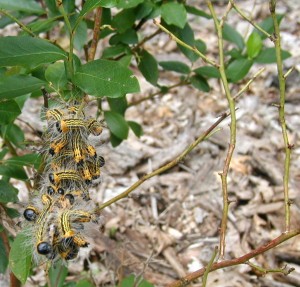Checking the fruit trees out back one day at the beginning of August, I saw two groups of yellow-orange and black-striped caterpillars. There were a dozen or more caterpillars all huddled at the ends of two empty branches of a blueberry bush. They must have eaten the blueberry leaves with abandon as all the leaves were gone on the stems that the squishy critters were found. None of the other four blueberry plants had any of these caterpillars.
Funny thing is I found them by spotting their poop. Those little grenades tend to collect under caterpillar feeding areas and give away the hungry camoflaged mouths.

Once you see the scat you can more easily spot the critters who deposited it. Caterpillars that have found the right food source will stay put and continue to feed, so their scat is usually directly below where they’ve been feeding. It’s a little surprising that I didn’t see the critters first, because they were all huddled together at the end of the branches.

Large grouping of caterpillars huddled on one stem near other stems that they stripped of leaves.

The blueberry shrubs and other fruit trees were checked often in the following weeks, but we haven’t seen this type of caterpillar again. I wonder what type of butterfly they would have morphed into. It’s really too bad they chose to eat from that blueberry bush!

Summer in Asheville, NC — just found them on one of my bushes & removed.
Hi Ellen!
Thanks for letting us know these buggers are in North Carolina, too.
Found a clump of them on my blueberries in Rhode Island this morning. Sprayed with Captain Jack’s in the rain, and two hours later they were on the ground dead. Have never seen them before.
Hey Sadie!
So now we know these blueberry-eating caterpillars don’t like rum in Rhode Island. OK!
I just found these on 2 blueberry bushes in my yard (Aug. 19) in Belfast, Maine. I just want to know what they are? Also, will they hurt the plant or can I let them be?
Saw them today for first time on one blueberry bush at Crystal Lake in Gilmanton IW NH.
Found some yesterday in Candor, NY!
Amsterdam OH
Just found some for the first time ever on my blueberry bushes. Trying also to find out what they are. May allow them to live out of curiosity. I have plenty of blueberries. We’ll see how much damage before I say “enough is enough”.
Found them on my river birch today.
Oh, a tree too! Thanks for your report John, what state are you in?
Hi Brenda,
I like your ‘let live’ approach. Just like the farmers around here who plant a little extra in their fields for the wildlife!
I watched these interesting caterpillars for a day on my blueberries and the next day they vanished. Was it because all the leaves were consumed on that plant? Or because a predator had a nice meal that night? It’s curious cuz there are other bushes that they could have crawled over to eat a lot more blueberry leaves. No need to kill them this time since they disappeared so quickly. It may have been that they were mature enough to burrow into the ground for their hibernation. See this yellow-necked caterpillar fact sheet from Penn State Ag.
Hey HoboFrog!
These caterpillars seem well-represented in the Northeastern parts of the U.S., New York state included. Thanks for sharing your observations!
So, B Widger, did you kill them? Now we know they’re in NH, too! Thanks!
Hi Joel!
I think you could let them be. Certainly, they’ll consume every leaf on a blueberry bush, but each time I’ve seen this happen the berry bushes still come back ok the next year. Perhaps the loss of leaves this late in the growing season really doesn’t hurt the plant. They’ll metamorphosize into adult moths.
Let us know what you decide!
Found them on my bushes today in Michigan. They have almost completely devoured a couple of bushes. Does anyone know what they are or what they turn in to? I raise honey bees and would prefer not to harm them but I would also like to keep my blueberries.
Hi Mary,
The yellow-necked caterpillars turn into moths as adults the following year. If they’ve already eaten the plants they’re likely getting ready to wriggle down to the ground where they burrow into the earth and overwinter. The adults will lay masses of white eggs on the leaves next summer so if you can spot the eggs masses then just rip off the “contaminated” leaves and you may be able to break the cycle. Good luck!
My son just discovered some crawling all over the trees in his treehouse! Are they poisonous? We’re in Charleston, SC
Hey Stacey!
No, they’re not poisonous. They’re just doing what nature intended…nibbling the tree leaves until they mature. Then, they’ll travel down to the ground, burrow in the earth and overwinter. No worries!!
Found some on my blueberry bush in GA. Figured I would let them live. The bishop should be fine for next year.
Hey Susan,
Welcome from Georgia! Yeah, it’s probably ok…you maybe even fed a bird or something else. 🙂
These catapilers defoliated much of my witch hazel tree. Will it come back next year. Also, my apple orchid is bare except the tops of tress. Will they survive, some of the trees look dead. Thanks. Alison
Hey Alison,
Yes, I think your trees will come back next year. It’s late in the season and they’ll soon be dropping their leaves anyway. If the trees have had a couple of very stressful years in a row, they could have a tough time though. When they’re stressed, just like us, the trees will become more susceptible to the natural pathogens out there in nature that can infect them. In a weakened state they just must succumb! We had a few trees die last year after losing a lot of leaf to gypsy moth larvae (other caterpillars!) followed by very dry then very wet conditions. Time will tell. Good luck!
I found these on My blueberry bushes today. I pulled about 15 off to give the chckens and they would not touch them. Made me curious as to what they were that chickens would stay away! (Eastern NC)
Hey Tommy!
That’s interesting that your chickens wouldn’t eat these little buggers. I wonder why not?! Maybe it’s that yellow “warning sign” color that spooked them. Nature has its ways! Thanks for sharing your experience from North Carolina.
Just spotted (and removed) several dozen of the caterpillars from a blueberry bush in Atlanta! The other dozen or so bushes had none.
Hi Ann from Atlanta!
Yes, these little buggers really do like to herd together. That’s one of the characteristics that helped us identify them. Strange behavior, isn’t it?
Thanks for your comment. Now other blueberry-lovers in Georgia will know what’s eating their bushes!
Thank you for this article. I found a large cluster on our Blueberry bush here in Leona Texas this morning. That’s halfway between Houston and Dallas. I wondered what was stripping the leaves and a closer look saw movement of their entangled striped bodies. We cut off the branch with a bag underneath so they would stay together and not travel to some other branch or plant. The other bush had none. June 10, 2019
Found some on one of my blueberry bushes. I am in Southwest MS and this is the first time I have had this issue.
Hi Pam!
Thanks for letting us know these critters are in Mississippi too. How did you remove them?
Y’all have them lots earlier than up here in Pennsylvania.
We look for them around the heat of the summer in late July and the beginning of August.
Well, Mary Lou, good on ya! Cutting off the whole branch was a simple way to get rid of the little buggers.
I’d still keep a watch for them – summer isn’t even here yet – so there’s plenty of hot air coming so maybe others will appear.
Thanks for letting us know Texas has these caterpillars too.
Hi. I’m in Alabama and they are here. My bush is almost completely stripped of leaves. I was hoping they didn’t kill it. It’s my first blueberry bush and they are wonderful. You all were very helpful. Thanks a bunch?
Just found an infestation on my Blueberries here in West Virginia near Morgantown. Had blueberries for 10 years – never saw them before. I knocked them into a bucket with a stick – headed for compost pile. Seems like taking them out might reduce the population next year.
Hi Jami!
I hope you got to eat all the berries that your tummy could handle before these critters denuded that bush.
Crossing fingers…I don’t think the bush is dead. Look for a few new leaves to sprout before winter rolls around.
Yes, blueberries are so delicious!
Thanks for sharing your story. 🙂
Hey Dick!
Taking out that garbage might or might not affect how many you see next year, but now you at least know what to look out for.
Isn’t it strange that you’d never seen them before now?
I just found several bundles of these guys on two of my three very mature blueberry bushes. (Northeast Ohio). First time we’ve seen these. My first inclination was to cut off the affected branches and kill the critters. But then I though, what if they are some sort of beautful butterfly, just waiting to happen?
This discussion is very helpful. Still not sure if I will leave them be, or move them along. Our blueberry yield is smaller this year than in the past. I don’t want to sacrifice any of my berries to these visitors.
It can be a hard decision, Beth. Should they stay or should they go?
Even though these caterpillars turn into not-so-stunning moths, what beautiful fruits do they help to create?
Not sure we know that part yet, so everybody keep watching!
I just noticed them for the first time on our blueberries here in Annapolis, MD. We’ve had domestic blueberries for about 5 years and wild ones in the woods around our how for…um..probably forever. I’ve never seen these before. I’ll leave them be this year. Birds need moths to eat. But if they get bad next year, I may take some reduction action. Thanks for all the comments. Weird that of all the plants in our woods, they’re eating only the blueberry bushes!
Yes, Gwynn, it can be a hard decision. Should they stay or should they go? I like your choice!
As for their desire of the blueberries I think there are lots of critters that are specialists requiring particular plants for their survival. Monarch butterflies are prime example in that they need milkweed plants for laying their eggs and then rearing their very young caterpillars. Even in larger animals we have other examples of specialists, like panda bears that require a certain plant, bamboo, for the majority of their diet.
Us humans are far from specialists – we’d be called generalists. We all know a lot of people who would eat just about anything!
Found them today on mature blueberry bushes for the first time! I live in Maine. They are certainly ravenous little critters!
Yes! These little buggers are voracious, aren’t they?
so- these are moths, not beautiful butterflies? I wanted to raise them! (Hudson, NH)
Yes, Ken, moths. Moths can be beautiful too, but I know most people would pick a colorful butterfly first.
If you want to raise them, let them live on your blueberry bush and just keep watching. Let us know how it goes!
I have just found them as 3 clumps of caterpillars on my blueberry plants in Southern Maine near Portland. Since 2 days ago they have totally denuded one of my plants and are onto the second. What type of moth do they become?
Hi Andra! That sounds exactly like my first experience with these little buggers.
The adult form of the so-called Yellow-Necked Caterpillar is a described as a reddish-brown moth. Eggs are laid on the undersides of leaves in June or July.
Robins are known to feed on the larvae so if you spot them on your blueberry bushes they may be eating the caterpillars and not the blueberries.
Thanks for all the info… I just found
these critters grouped together ON OUR
BLUEBERY BUSHES in south/central PA.
Waiting to consult with hubby before we do anything…
I want to get rid of them…
It took too long to get blueberry bushes established!!
I know what you mean, Lisa. Once the bushes are a few years old they will provide plenty of blueberries.
Provided, of course, that mother nature doesn’t have other critters in line first!
If you don’t get rid of them, expect this generation of caterpillars to emerge next year as adults that will lay eggs to keep the cycle going.
Good luck on your decision!
I have a lot of blueberry bushes on my lake front lot here in Maine. I found one bunch of the caterpillars on a branch and looked for your site for answers . I now know what to do. I cut the branch and drowned them under a rock
Drexel’s Datana moth or closely related species. Found some in CT. From reading various sources it seems like finding them in CT may be more likely because of warming weather trends. Most earlier reports seem to suggest that this insect’s range has been expanding northward.
Well, Robert, I don’t think you’ll be bothered by them next year.
Good luck!
Not if we can help it! LOL!
Of course, nature will do as it does and we’ll just hope for a little of the blueberry harvest for ourselves.
Instead of killing the caterpillars maybe we should just plant another bush and let the critters survive too.
Who knows which ones depend on the moths or caterpillars for their dinner?
Thanks for chiming in, Bill!